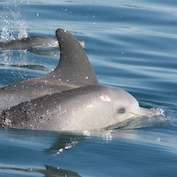Health check for Swan River dolphins

Murdoch University researchers have commenced a new study investigating the health of the dolphins inhabiting the Swan Canning Riverpark.
The project, funded by the Swan River Trust, will use a novel 'biomarker' technique to assess the potential impact of contaminants on dolphin health. Biomarkers are measurable cellular or biochemical changes caused by exposure to foreign chemicals.
"Small skin samples will be collected using remote biopsy equipment and tested for a range of contaminants and biomarkers," said veterinary pathologist and researcher Dr Nahiid Stephens.
"The biomarkers reflect the expression level of several genes. The presence and/or effect of foreign chemicals can change how these genes 'express' themselves."
Dr Stephens said the approach gives researchers a new and powerful tool, allowing them to collect baseline data about the health of the Swan River dolphins, as well as allowing long-term monitoring.
"This method has only been applied in relatively few studies globally, but to great effect," she said.
"It is particularly important for wildlife as researchers can't take routine samples, such as blood, for testing."
Concerns about the effect of estuarine contaminants on dolphin health were raised in 2009, following the deaths of six dolphins in the Riverpark.
Post-mortem testing identified the presence of certain industrial and agricultural substances in dolphin tissues. Subsequent tests revealed that cetacean morbillivirus played a major role in some of the deaths, as it suppresses the immune system of whales and dolphins. The virus had not been documented in the Indian Ocean previously.
It remains unclear whether contaminants contributed to the 2009 deaths.
Dr Stephens said the deaths highlighted the vulnerability of the Swan River dolphins, but that tests on deceased dolphins aren't necessarily a good indicator of the health of the live population.
"For example, exposure to a pathogen like cetacean morbillivirus can lead to changes in feeding habits, metabolism and weight," she said.
"These factors can alter the levels of contaminants in different tissues, making it impossible to identify the particular contribution, if any, of the contaminants present.
"That's why it's important for us to collect skin samples from live, outwardly healthy dolphins."
Researchers hope to conduct similar studies on the health of other potentially vulnerable estuarine dolphin populations in Western Australia.
Provided by Murdoch University
















